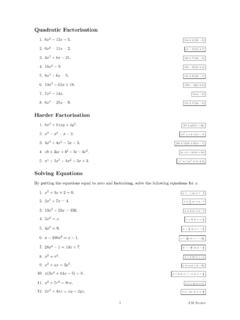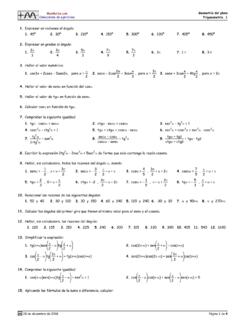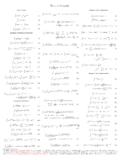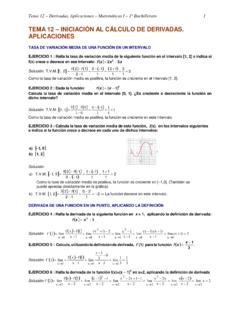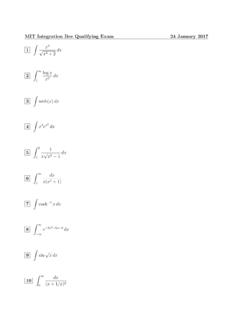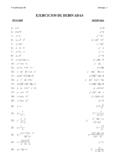Transcription of OCR Core 4 Module RevisionSheet - Mathshelper
1 OCR core 4 Module Revision SheetThe C4 exam is 1 hour 30 minutes long. You are allowed a graphics you go into the exam make sure you are fully aware of thecontents of the formula bookletyou receive. Also be sure not to panic; it is not uncommon to get stuck on a question (I vebeen there!). Just continue with what you can do and return atthe end to the question(s)you have found hard. If you have time check all your work, especially the first question youattempted.. always an area prone to Review binomial expansion from C2 for (x+y)nfor positive integern. Notice that it isvalid foranyxandyand that the expansion hasn+ 1 terms. The general binomial expansion is given by(1 +x)n= 1 +nx+n(n 1)2!x2+n(n 1)(n 2)3!x3+ and is valid for anyn(fractional or negative) but 1< x <1 ( |x|<1).
2 Notice alsoit must start with a 1 in the brackets. For example expand (4 x) 1/2.(4 x) 1/2= 4 1 x4 1/2=12 1 x4 1/2=12"1 + 12 x4 +( 12)( 32)2! x4 2+( 12)( 32)( 52)3! x4 3+ #=12 1 +x8+3x2128+15x33072+ =12+x16+3x2256+15x36144+ .It is only valid for|x/4|<1 |x|<4. Another example: Find first 3 terms in the expansion for(3 +x)21 +x2.(3 +x)2 1 +x2 1= (9 + 6x+x2) 1 x2+x24+.. = 9 +32x+14x2+.. You must be able to simplify algebraic fractions; best tactic is always to factorise andcancel:4x5 10x4 6x312x6 18x5 12x4=2x3(2x2 5x 3)6x4(2x2 3x 2)=2x3(2x+ 1)(x 3)6x4(x 2)(2x+ 1)=x 33x(x 2). You must be able to divide a polynomial (p(x)) by a divisor (a(x)), finding the quotient(q(x)) and remainder (r(x)). If there is no remainder thena(x) is a factor ofp(x). It isalways such thatp(x)a(x)=q(x) +r(x)a(x) p(x) =a(x)q(x) +r(x).
3 Order ofq(x) is the order ofp(x) subtract the order ofa(x). The order ofr(x) isatmostone less thana(x). For example if you have a quintic (power 5 polynomial) dividedby a quadratic you would expectquinticquadratic= cubic +linearquadratic,quinticquadratic=Ax3+Bx 2+Cx+D+Ex+ course itmayturn out thatEx+Fis just a constant or zero (if the cubic divides thequintic). Division is most easily done step-by-step workingdownthe powers ofp(x). For exampledivide 2x4 x3+ 3x2 7x+ 1 byx2+ 2x+ 3:2x4 x3+ 3x2 7x+ 1 = (x2+ 2x+ 3)(quadratic) + (remainder)= (x2+ 2x+ 3)(2x2+..) + (remainder)x4X= (x2+ 2x+ 3)(2x2 5x+..) + (remainder)x3X= (x2+ 2x+ 3)(2x2 5x+ 7) + (remainder)x2X= (x2+ 2x+ 3)(2x2 5x+ 7) 6x+ (x2+ 2x+ 3)(2x2 5x+ 7) 6x (x) = 2x2 5x+ 7 andr(x) = 6x 20. Partial fractions is effectively the reverse of combining together two algebraic example1x+ 1+1x+ 2 Algebraic FractionsPartial Fractions 2x+ 3(x+ 1)(x+ 2).
4 You can use partial fractions provided the order of the top line is less than the order ofthe bottom line. If you simply have a product of linear factors on the bottom line then you split out intothat many terms with constants placed on top (usually denoted byA,B,C, etc.). Placethis equal (in an identity ) to the original expression and then multiply through toget rid of the denominators. For example:7x 1(2x+ 1)(x 1) A2x+ 1+Bx 1 7x 1 (x 1)A+ (2x+ 1) this is an identity we can choose any value ofxwe fancy to help us discoverAandB. In this case lettingx= 1 is a good choice because one of the brackets becomezero. Similarlyx= 12is another good choice1; we put these into the 1 7 1 3B B= 2,x= 12 72 1 32A A= 1(2x+ 1)(x 1) 32x+ 1+2x you don t spot (or run out of) clever values to use, fret not!
5 Just put in some other numbers (usuallysomething nice likex= 0,x= 1 orx= 1) and solve the resulting equations. If your girlfriend s lucky numberis 53 and your mistress s lucky number is 178 then feel free touse those if you wish, although I wouldn t adviseit; choose simple numbers! If you have a repeated factor in the denominator then you dealwith it as follows (noticethe top line is a quadratic and the bottom a cubic, so partial fractions are fine):5x2 10x+ 1(x 3)(x 1)2 Ax 3+Bx 1+C(x 1)2 5x2 10x+ 1 (x 1)2A+ (x 3)(x 1)B+ (x 3) , good values ofxto choose arex= 1 andx= 3:x= 1 5 10 + 1 2C C= 2,x= 3 45 30 + 1 4A A= tells us that5x2 10x+ 1 4(x 1)2+ (x 3)(x 1)B+ 2(x 3),but it hasn t told usB. I would considerx= 0, here, and sub in to discover0 0 + 1 4 + 3B 6 B= 10x+ 1(x 3)(x 1)2 4x 3+1x 1+2(x 1)2.
6 Partial fractions are often very useful in evaluating integrals. If you see a quadratic in thebottom line of an integral, then one option your brain shouldturn to is can this be splitinto partial fractions? . For example in this integral, it can be split and then integrated:Zx+ 10x2+ 5x+ 4dx=Zx+ 10(x+ 1)(x+ 4)dx=Z3x+ 1 2x+ 4dx= 3 ln(x+ 1) 2 ln(x+ 4) + & Integration Know the contents of the formula booklet well. Very well! Lots of problems can be solvedsimply by looking at the table of differentials and integrals and knowing that integration undoes a differentiation. Some questions get you to differentiate something andthengetyou to integrate something view the question as a whole! When using radians we can differentiate the trigonometric functions. The results are asfollows:y= sinxy= cosxy= tanxdydx= cosx,dydx= sinx,dydx= can derive the third result from the other two using the quotient rule and thattanx sinxcosx.
7 You can also use these results along with the chain rule to differentiate functions like thefollowing;y= sin(x2+ 1) by lettingu=x2+ 1 andy= (tanx)10by lettingu= sin(x2+ 1)y= (tanx)10dydx= 2xcos(x2+ 1),dydx= 10 sec2x(tanx) Integration by substitution is a way of integrating by replacing the variable given to you(usuallyx) and replacing it by another (usuallyu). These days the substitution you areto use is given to you in the exam, but practice will get you better at spotting what tosubstitute (usually the most complicated term in the integration or the denominator of afraction). For exampleRx3(x4+ 1)7dxwe should useu=x4+ (x4+ 1)7dxu=x4+ 1=Zx3u7dxdudx= 4x3=Zx3u7du4x3du4x3=dx=14Zu7du=u832+c=(x 4+ 1)832+ have effectively used and abused uto help us to get the answer. (Note: I havebeenverysloppy in the above integration because I have mixed myxanduvariables; youshouldn t really do this, but it makes the process of conversion clearer.)
8 When dealing with definite integrals we need to also convert the limits of the integrationand there is no need to convert back toxat the end since all definite integrals are merelynumbers. For exampleZ432xpx2 4dxu=x2 4x= 3 u= 5=Z1252xu1/2du2xdudx= 2xx= 4 u= 12=Z125u1/2dudu2x=dx= 23u3/2 125= (3sf). Know the resultReaxdx=1aeax+c. We know that ify=ef(x)thendydx=f (x)ef(x). Therefore by reversal we findZf (x)ef(x)dx=ef(x)+ example2Zx3ex4dx=14Z4x3ex4dx=14ex4+c. Know thatR1xdx= lnx+c. We know (by the chain rule) that ify= ln(f(x)) thendydx=f (x)f(x). Therefore by reversalwe findZf (x)f(x)dx= ln|f(x)|+ could also have been evaluated (more slowly) by a substitution ofu=x4which would then have reducedto x3ex4dx=14 eudu=14ex4+ on the lookout for expressions where the top line is almostthe derivative of the bottomline.
9 For example3Zx3x4+ 1dx=14Z4x3x4+ 1dx=14ln|x4+ 1|+c. Know the resultsZcosax dx=1asinax+candZsinax dx= 1acosax+c. Always be on the look out for integrals involving a mixture oftrigonometric are usually handled by means of a substitution. For exampleRcosx(sinx)7dxisbest handled byu= sinxto give18(sinx)8+c. Also know the useful results (all derived from reverse chainrule)Zf (x) cosf(x)dx= sinf(x) +candZf (x) sinf(x)dx= cosf(x) + exampleRx3cos(x4)dx=14sin(x4) +c. When an integral is made up of two bits then we can sometimesuseintegration by statesZudvdxdx=uv you will need to decide which bit of the integral you willneed to differentiate andwhich part to integrate. For example inRxsinx dxit is quite clear that we will need todifferentiate thex part and integrate the sinx part.
10 Zxsinx dx= xcosx Z cosx dx= xcosx+ sinx+c. Another example (this time a definite integral)Z20xe2xdx= 12xe2x 20 Z2012e2xdx= 12xe2x 20 14e2x 20= e4 0 e44 14 =3e44+14. InitiallyRlnx dxlooks nothing like it has anything to do with integration by parts becauseit only has one part . However if we write lnxas 1 lnxwe can integrate the 1 anddifferentiate the lnx:Zlnx dx=Z1 lnx dx=xlnx x+ principle can be extended to integrals of the typeRxnlnx dx:Zxnlnx dx=xn+1n+1lnx Zxn+1n+ +1n+1lnx xn+1(n+1)2+ , this could also have been evaluated by the substitutionu=x4+ Very occasionally you will need to integrate by partstwiceto get the final answer. Thiswill almost always be of the formRkx2(something)dx. For example findRx2e2xdx:Zx2e2xdx=x22e2x Zxe2xdx =x22e2x x2e2x Z12e2xdx =x22e2x x2e2x 14e2x +c=x22e2x x2e2x+14e2x+c.





